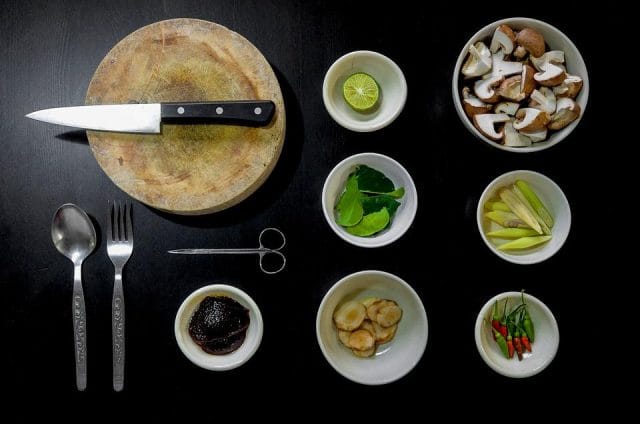This post is adapted from the blog of wellio, a Priceonomics Data Studio customer. Does your company have interesting data? Become a Priceonomics customer.
***
Intuitively, we all know there are benefits to cooking at home. You can use healthier ingredients, set portions to a reasonable size, avoid food allergies, and of course you can save money compared to ordering restaurant delivery or using a meal kit service.
But just how much money do you save by cooking at home? We decided to analyze our recipe data to find out the true cost of cooking at home from scratch, compared to delivery from a restaurant or a meal kit service.
We analyzed data from Priceonomics customer wellio, a platform that breaks down millions of recipes into single ingredients and matching those to grocery items from local stores. That allows us to measure the ingredient cost for a wide variety of recipes. For 86 popular dinner recipes, we decided to look at the average cost per serving of cooking from scratch and compare it to the cost per serving of ordering from a restaurant or a meal kit delivery service.
We found on average, it is almost five times more expensive to order delivery from a restaurant than it is to cook at home. And if you’re using a meal kit service as a shortcut to a home cooked meal, it’s a bit more affordable, but still almost three times as expensive as cooking from scratch.
When cooking at home, you’ll save a substantial amount of money on carb-based meals like pasta or pizza, and you’ll save the most on protein-based meals when compared to ordering from a restaurant or meal kits.
***
Before diving into the results, let’s spend a moment on the methodology of this analysis. We looked at 86 popular meals and examined how much it would cost to acquire them as: groceries for home cooking, restaurant delivery or meal kit delivery. For home cooking, we’ve calculated the price per serving based on the consumed portion of ingredients. For example, you purchase a whole onion for the recipe, which requires half an onion per serving, so the price per serving is ½ of the onion. To be clear, this is an analysis of your costs and isn’t about looking at opportunity costs of time associated with cooking.
For restaurant delivery, we looked up menu prices on the websites of the following national restaurant chains: Applebee’s, Cheesecake Factory, Chevy’s, Chili’s, Lyfe Kitchen, Maggiano’s, and P.F. Chang’s. Then added an average $5 delivery fee based on delivery prices from Caviar, UberEats, and Grubhub. Since meals sold within a meal kit are usually part of a bundle, we took the average price of a meal across the bundle and then allocated a $2.50 delivery fee per meal. For home cooking, we looked at the cost of ingredients according to wellio, based on Whole Foods Market, a national grocery chain with quality products.
First, let’s look at the average costs of the meals we analyzed depending on if you acquired them from a restaurant versus meals kits versus cooking at home from scratch.
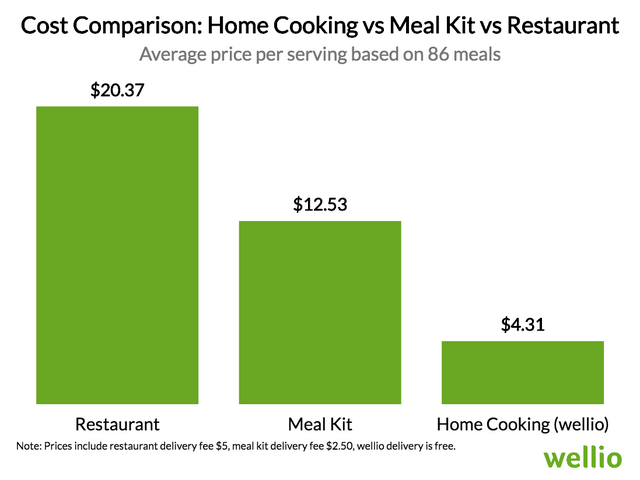
By far, getting dinner delivered from a restaurant is the most expensive meal option.
At over $20 per serving on average, a restaurant delivered meal is almost three times as expensive as a meal kit and five times as expensive as cooking at home from scratch. Obviously when you cook at home, you’ll spend more time but you usually end up with a healthier meal because you’re the one to decide what exactly goes into it.
Next, let’s look at the cost of getting specific meals delivered via restaurant delivery versus making the meal from scratch. Of course, there are “cheaper” places to buy these restaurant meals, but these are the prices published on restaurant websites in our sample of mostly national chains.
Which meals save you the most when you roll up your sleeves and cook instead of picking up your phone to order?
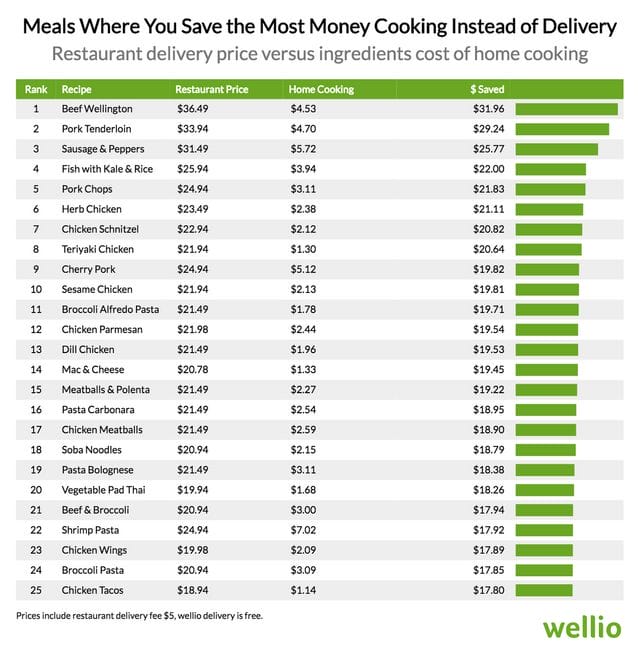
At the top of the list, the meals you can save the most money by cooking at home are heavily protein based entrees. As it turns out, restaurants charge a lot of money for meals that have beef, pork, and chicken. When you factor in a delivery cost, your price per meal can easily exceed $20 per person (and sometimes even more than $30 per person!).
To better understand this comparison, let’s look at an example of the price per serving breakdown for Pork Tenderloin, one of the top money-saving meals when cooking at home from the list above.
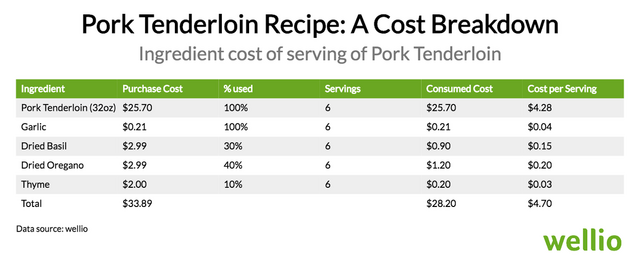
Also appearing throughout the list are pasta-based meals like Broccoli Alfredo, Pad Thai, Pasta Bolognese and Soba Noodles. If you buy these from a restaurant you will pay “entree” prices of about $20. However you can easily make these meals at home and save 80-90% per serving.
Restaurant delivery, however, isn’t the only alternative to cooking at home. You can also have meal kits delivered to your house. These kits are sold at a premium compared to cooking from scratch because the raw ingredients are pre-assembled and pre-portioned for you.
If you’re looking to save money, when should you avoid meal kits and instead cook from scratch at home?
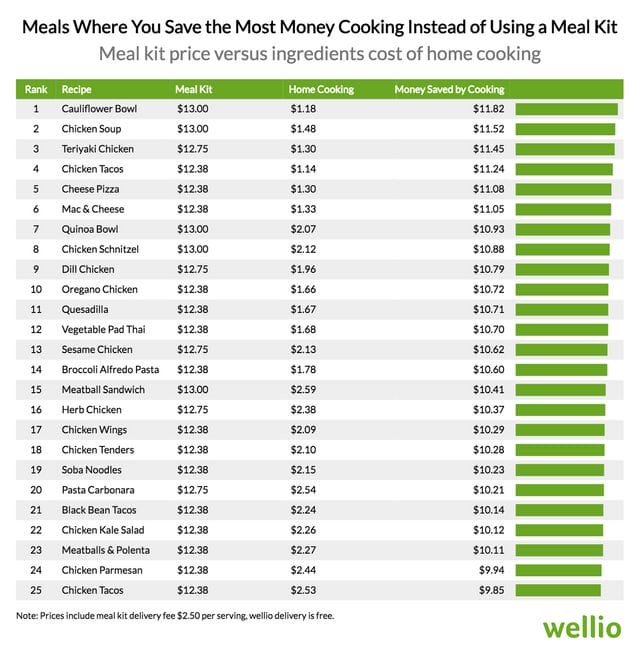
For vegetable and pasta-based meals, frankly, it’s really cheap to make them at home while meal kits still charge a lot for them.
In the above list, for example, making a Cheese Pizza, Mac & Cheese, Cauliflower or Quinoa bowl is incredibly inexpensive to make at home — it only costs about a dollar per serving! However, these are the type of meals where meal kits are the worst value since you’ll be paying around $12 for them as part of the “bundle” you’re required to purchase (that also includes delivery fee).
Eating meat through a meal kit is about half as expensive as ordering it from a restaurant, but still much more expensive than making it yourself. A few meat-based meals stand out as being much more expensive with a meal kit than home cooking — Cilantro Lime Chicken, Chicken Soup, and Teriyaki Chicken make the top ten worst meal kit deals compared to home cooking.
Lastly, let’s look at all the data. The below chart shows the prices of all 86 meals we analyzed from a meal kit service, a restaurant, or making it at home from scratch.
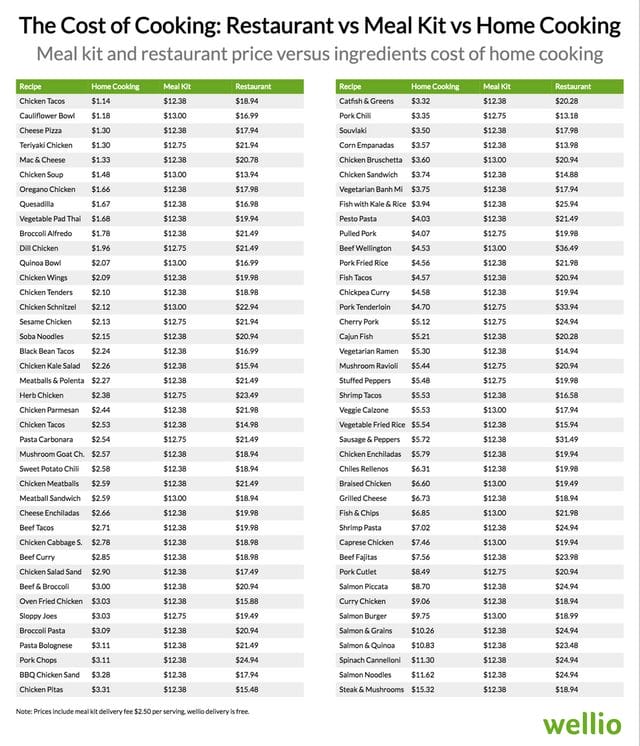
What rules of thumb can be gleaned from looking at all this data?
First, If meat is involved, you can save a lot of money by making the dish at home instead of ordering it from a restaurant. These types of dishes are the most expensive entrees on the menu at restaurants but don’t cost you that much to cook from scratch.
Second, if the ingredients are items like flour, cheese, and pasta, which are very inexpensive at the grocery store, avoid getting them from a meal kit service. On the other hand, meal kits can be a pretty good option if you want to cook more complicated meals with many ingredients, especially a meal like Curry Chicken which has many spices.
Lastly, cooking at home saves you money across the board. Although you will spend more time then ordering delivery from a restaurant, you will get a nutritious and delicious meal for about $4 a person.
***
Note: If you’re a company that wants to work with Priceonomics to turn your data into great stories, learn more about the Priceonomics Data Studio.




